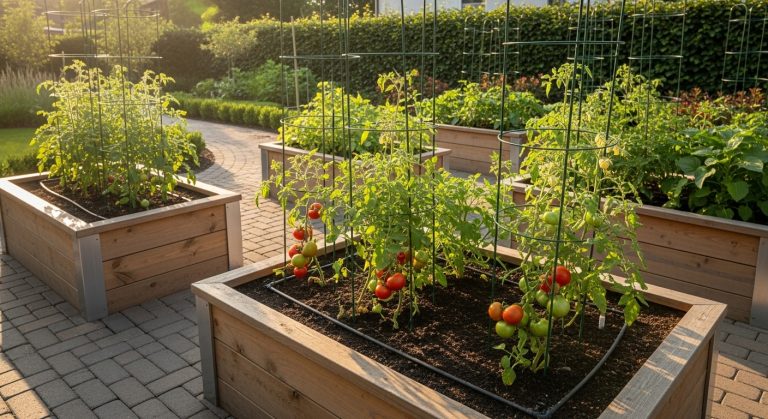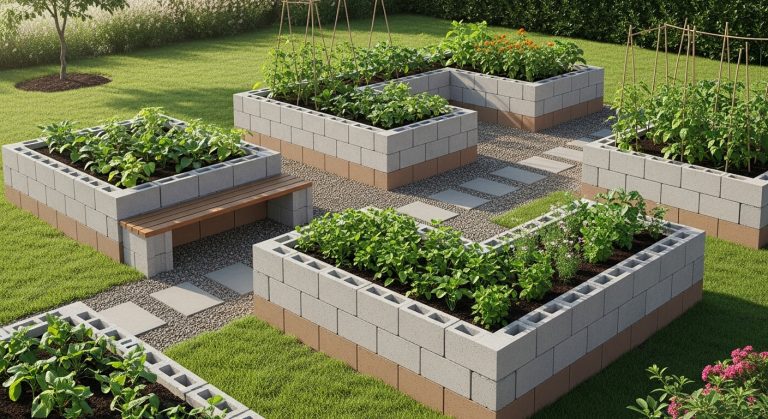Raised Garden Beds on a Slope: 15 Brilliant Ways to Make the Most of Your Uneven Yard
Ever looked at your sloped backyard and thought, “Well, there goes my dream garden?” Hold that thought! A sloping yard isn’t a gardening curse—it’s a creative opportunity. With a little imagination (and maybe some wood, stones, or recycled metal), you can build raised garden beds on a slope that look amazing and make your garden thrive.
Whether you’re dealing with a gentle incline or a mini mountain, these 15 ideas will help you turn that awkward slope into a show-stopping landscape that’s both functional and beautiful.
1. Tiered Wooden Garden Beds

Building tiered wooden beds is one of the most classic and visually stunning ways to tackle a slope. Each tier acts as its own mini garden level—perfect for separating veggies, herbs, and flowers.
Pros:
- Perfect for controlling soil erosion.
- Creates an eye-catching, organized layout.
- Easy to maintain watering and drainage levels.
Cons:
- Requires more lumber and time to construct.
- Wood can degrade faster in wet conditions unless sealed.
Pro tip: Use treated or cedar wood to prevent rot—it’ll last for years without losing that natural charm.
2. Stone Retaining Wall Beds

If you love a rustic, natural aesthetic, stone beds are your go-to. You can use stacked stones or bricks to create sturdy terraces that blend beautifully into the landscape.
Pros:
- Super durable and weather-resistant.
- Adds a timeless, natural look to your slope.
- Great for temperature regulation for plants.
Cons:
- Heavy labor if you’re doing it yourself.
- Can get pricey depending on stone type.
FYI, according to Houzz Landscape Trends 2024, homeowners are increasingly turning to stone retaining beds for their longevity and natural appeal—especially in hilly regions.
3. Corrugated Metal Beds with Steps
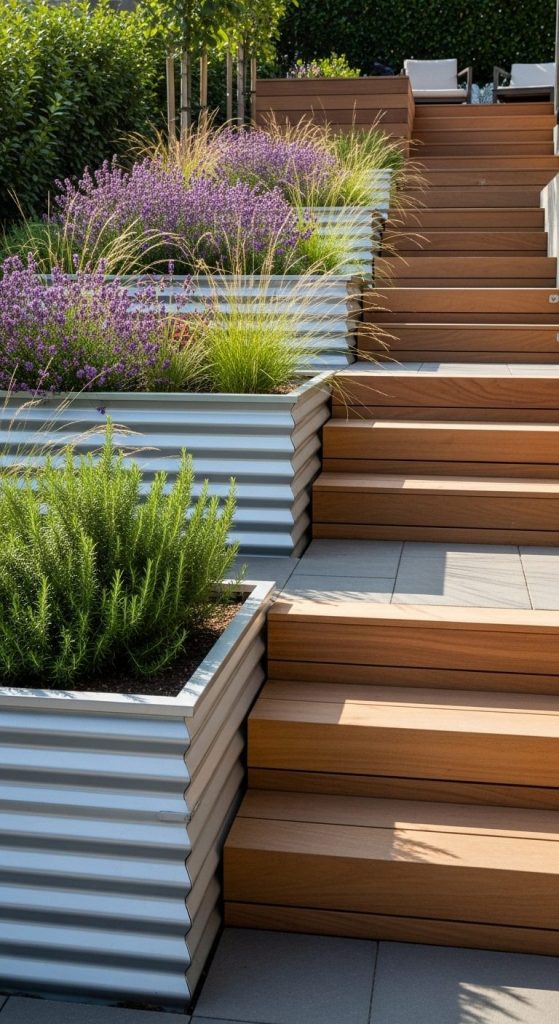
Want something industrial and modern? Corrugated metal garden beds work wonders on slopes. Pair them with wooden steps for easy access and a striking contrast in textures.
Pros:
- Extremely durable and rot-resistant.
- Great for contemporary outdoor design lovers.
- Quick to install compared to stone or timber.
Cons:
- Can heat up quickly in direct sunlight (watch your plants!).
- A bit costlier upfront.
Ever wondered why these are trending? Because they’re practically zero-maintenance and last decades.
4. Railroad Tie Terraces

If you want a rugged, farm-style garden, railroad ties (or reclaimed timber beams) are perfect. They add character and authenticity to a sloped garden.
Pros:
- Sturdy, rustic, and long-lasting.
- Ideal for creating multi-level layouts.
- Budget-friendly if using reclaimed wood.
Cons:
- Some old ties may contain chemicals—opt for eco-safe ones.
- Heavier to work with than standard lumber.
This setup turns your slope into a layered paradise—and your neighbors will think you hired a landscape designer.
5. Curved Raised Beds
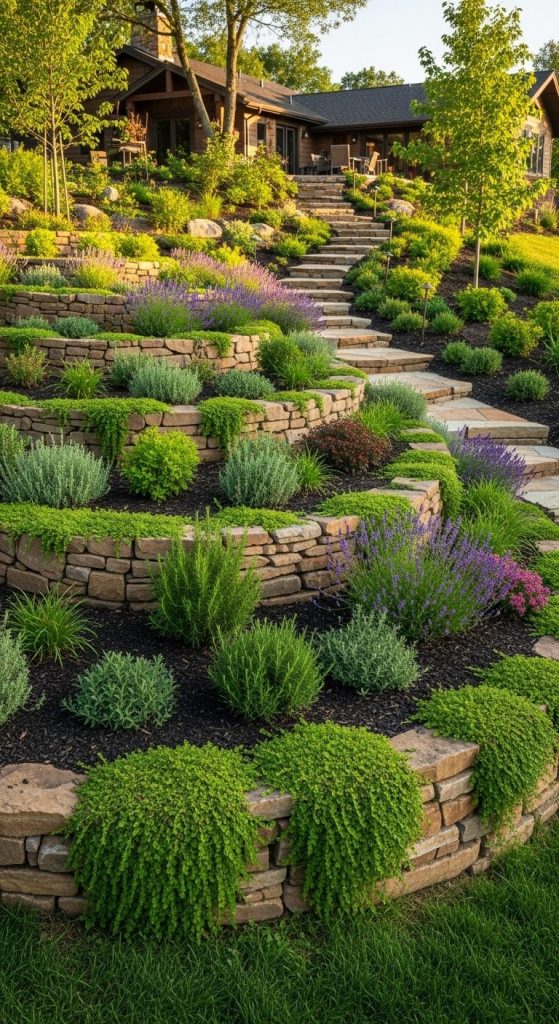
Who says your raised garden beds have to be straight lines? On a slope, curves can help follow the natural contour of the land while adding visual flow.
Pros:
- Looks organic and elegant.
- Reduces soil erosion naturally.
- Works great with stone or metal edging.
Cons:
- Takes more planning to get the layout right.
- Slightly harder to build than rectangular beds.
You’ll love how the design softens your yard—like the garden just belongs there.
6. Log Border Beds
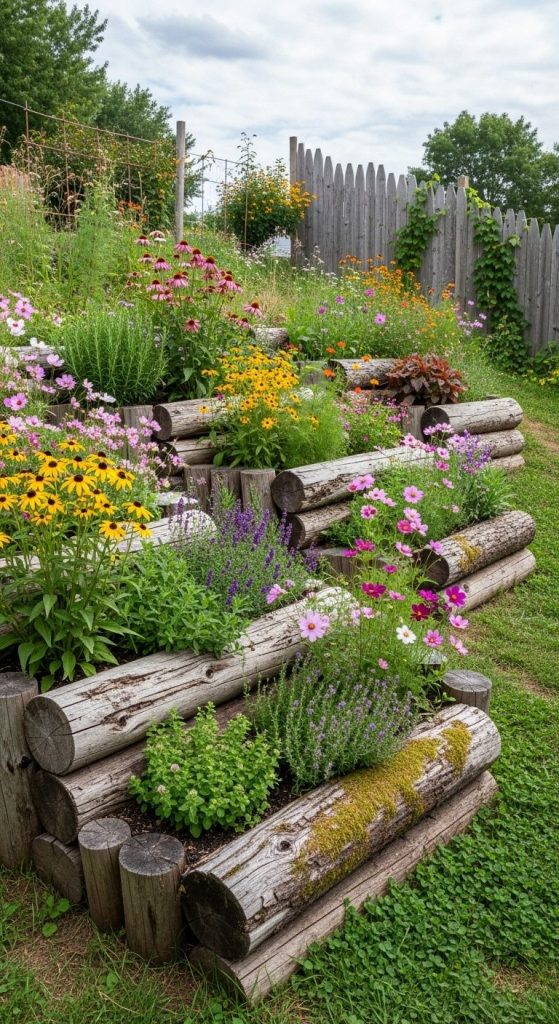
This one’s for the eco-friendly gardener. Use fallen logs or reclaimed timber to create natural, raised borders along your slope.
Pros:
- Cheap or even free if you source locally.
- Blends perfectly with forest or country landscapes.
- Encourages beneficial insects and fungi.
Cons:
- Wood decomposes over time.
- Not ideal for very steep slopes.
IMO, this is the perfect “lazy gardener” solution—it looks rustic and requires almost no precision.
7. Brick-Lined Planters

Brick beds are an awesome mix of durability and charm. They’re great for smaller slopes where you want a tidy, traditional feel.
Pros:
- Adds color and structure to any garden.
- Low maintenance once set up.
- Excellent for retaining heat in cooler climates.
Cons:
- Mortar may crack if drainage isn’t managed well.
- Slightly higher initial cost.
Fun fact: Brick’s thermal mass can keep soil warmer overnight—great for extending growing seasons.
8. Gabion Wall Beds

Gabions—those wire cages filled with rocks—look ultra-modern and can handle even steep slopes. Plus, they double as striking landscape features.
Pros:
- Indestructible against erosion.
- Adds a designer-level look to your garden.
- Customizable in height and shape.
Cons:
- Requires careful assembly and materials.
- Can be expensive for larger projects.
Architects love them because they mix form and function beautifully. Just imagine vegetables growing out of a rock wall—it’s art meets agriculture.
9. Stepped Planter Boxes

Think of this as a vertical garden meets terrace farming. Each box steps up or down your slope, making use of every inch of space.
Pros:
- Compact and efficient for small yards.
- Great for herbs, strawberries, or succulents.
- Prevents runoff and erosion.
Cons:
- Needs solid anchoring for stability.
- May require drip irrigation for even watering.
You’ll feel like a genius when you see how tidy and organized your slope looks.
10. Retaining Wall Beds with Seating
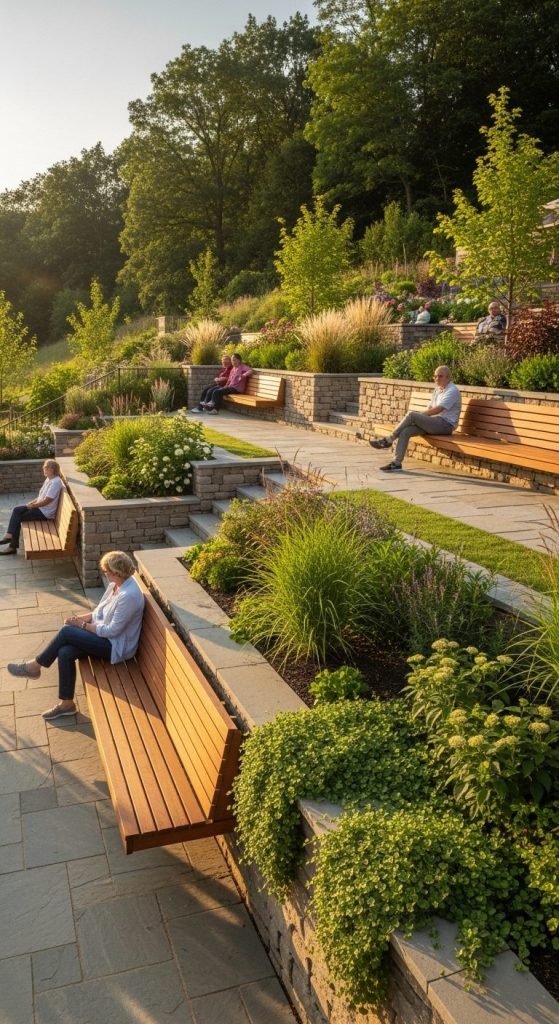
Why not make your slope garden double as a relaxation spot? Build a retaining wall with integrated benches or seating areas.
Pros:
- Combines function and leisure.
- Adds instant backyard charm.
- Makes gardening breaks a lot comfier!
Cons:
- Requires more materials and design planning.
- Slightly costlier than simple beds.
According to Better Homes & Gardens, multi-use landscaping elements like these boost property value significantly.
11. Recycled Pallet Beds

Pallets are a DIY favorite—and yes, you can use them for raised garden beds on a slope too!
Pros:
- Cheap, eco-friendly, and customizable.
- Easy to move or adjust later.
- Great for fast, weekend builds.
Cons:
- Pallet wood can rot faster than hardwood.
- Requires careful checking for chemical treatments.
IMO, this is the “DIY-for-the-win” option—practical, stylish, and sustainable.
12. Concrete Block Terraces

Concrete blocks are like LEGO for adults. They make it easy to create level, raised garden beds that hold their shape for years.
Pros:
- Extremely durable and affordable.
- Simple to assemble.
- Works for steep or gentle slopes alike.
Cons:
- Industrial look might not fit every aesthetic.
- Heavy to lift and position.
For a softer look, fill block holes with trailing plants like thyme or alyssum. Instant charm!
13. Mixed Material Beds
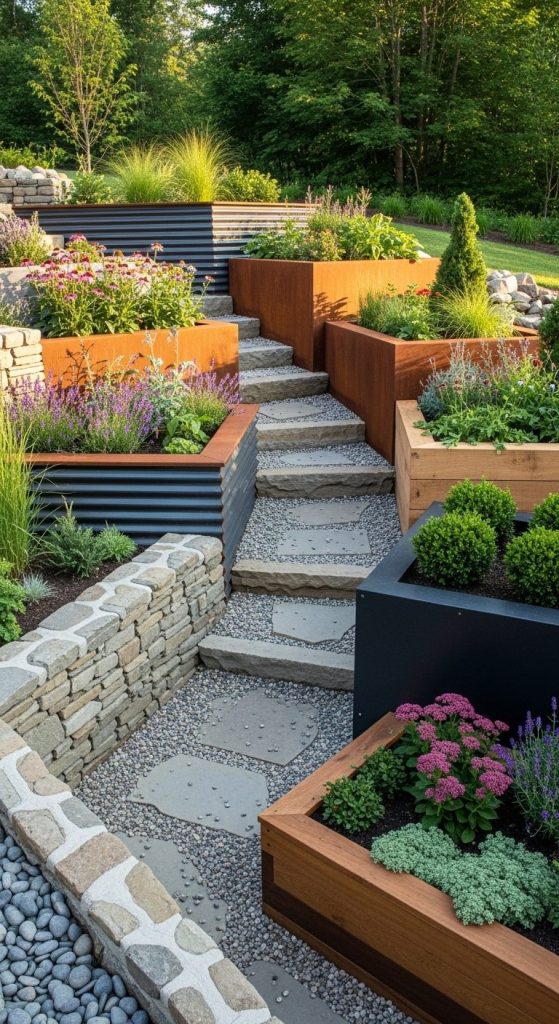
Why stick to one material? Mix wood, metal, and stone for a creative, textural look. It’s both functional and artsy.
Pros:
- Customizable and unique.
- Lets you use leftover materials.
- Adds depth and visual interest.
Cons:
- Harder to match finishes neatly.
- Needs design balance to avoid clutter.
This one’s for rule-breakers who want their garden to scream personality.
14. Water-Wise Terraced Beds
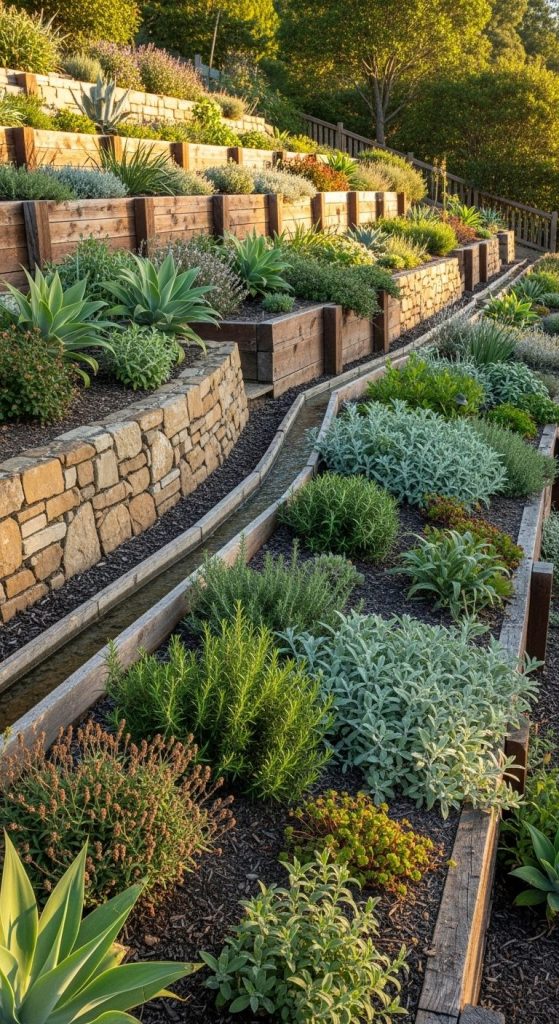
If you live somewhere dry, you’ll love this idea. Design terraced raised beds that naturally channel water from one level to the next—zero waste.
Pros:
- Great for drought-prone regions.
- Reduces manual watering needs.
- Improves plant health with consistent moisture.
Cons:
- Requires careful grading and planning.
- Not ideal for super rocky terrain.
Fun fact: According to Statista, nearly 65% of gardeners now use water-saving designs. Smart and sustainable.
15. Flower-Filled Slope Garden
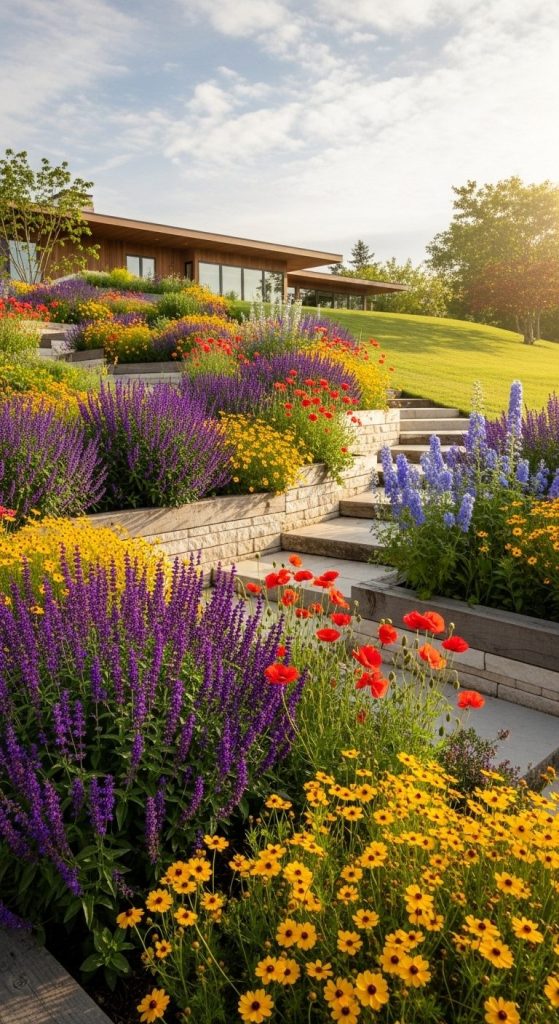
Who says raised garden beds on a slope are just for veggies? Fill your tiers with colorful blooms instead for an instant backyard showpiece.
Pros:
- Adds instant curb appeal.
- Encourages pollinators like bees and butterflies.
- Low-maintenance once established.
Cons:
- Less functional for edible gardening.
- May require replanting each season.
It’s like having a natural amphitheater of color right in your yard—pretty hard to beat.
Final Thoughts
A sloped yard might look intimidating at first, but once you start experimenting with raised garden beds on a slope, you’ll realize it’s a total game-changer. From tiered wood structures to gabion art walls, your uneven ground can become your biggest asset.
So, grab those gloves and start designing your dream slope garden. And hey—if you mess up the first level, call it “organic landscaping.” Works every time.

William Martin is a passionate bowler who spends most of his weekends playing the sport. With years of intense experience under his belt, William decided to share his knowledge by creating BOWLING OCEAN. Join me on this journey to explore the world of bowling and discover the tips and tricks to becoming a pro.


